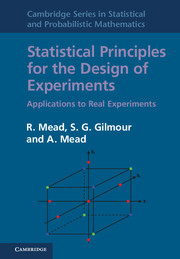Book contents
- Frontmatter
- Contents
- Preface
- Part I Overture
- Part II First subject
- Part III Second subject
- 12 Experimental objectives, treatments and treatment structures
- 13 Factorial structure and particular forms of effects
- 14 Fractional replication
- 15 Incomplete block size for factorial experiments
- 16 Quantitative factors and response functions
- 17 Multifactorial designs for quantitative factors
- 18 Split-unit designs
- Part IV Coda
- References
- Index
13 - Factorial structure and particular forms of effects
from Part III - Second subject
Published online by Cambridge University Press: 05 November 2012
- Frontmatter
- Contents
- Preface
- Part I Overture
- Part II First subject
- Part III Second subject
- 12 Experimental objectives, treatments and treatment structures
- 13 Factorial structure and particular forms of effects
- 14 Fractional replication
- 15 Incomplete block size for factorial experiments
- 16 Quantitative factors and response functions
- 17 Multifactorial designs for quantitative factors
- 18 Split-unit designs
- Part IV Coda
- References
- Index
Summary
Preliminary example
Suppose eight treatments comprising all combinations of three two-level factors P, Q and R are compared and the resulting treatment means are shown in Table 13.1. What is the best estimate of the difference between the two treatment combinations p1q1r1 and p1q1r0? Or, in practical terms, if you have decided to recommend the upper levels of factors P and Q, what is the benefit of using r1 rather than r0? If you think there is only one possible answer, then you have not yet fully grasped the benefits of factorial structure.With a little effort, you should be able to find at least six different conceivable answers.
Factors with two levels only
In Chapters 3 and 12, we started to examine the general advantages of using experimental treatments with a factorial structure. In this chapter, we look in more detail at special forms of factorial structure to examine how the general advantages manifest themselves in particular cases, and we develop methods for using further advantages of these special forms.
The first special form of factorial to consider is that in which all factors have two levels. There are many reasons why this is an interesting form to examine in detail. First, it is a sensible practical solution for many scientific situations. We can think of one level of each factor as being the normal mode and the other level as a new, alternative mode.
- Type
- Chapter
- Information
- Statistical Principles for the Design of ExperimentsApplications to Real Experiments, pp. 305 - 333Publisher: Cambridge University PressPrint publication year: 2012



